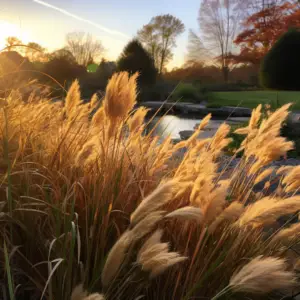Dividing Ornamental Grasses, Ornamental grasses are plants that are often considered garden decorations or accent plants.
Gardeners and homeowners often find ornamental grasses attractive options as they can use them as fillers for large spaces and as an inexpensive form of green landscape.
Whether the intention is to revitalize an old lawn, control weeds, or grow something different from typical dog-friendly grass, there are many ways to use ornamental grasses.
They are easy to grow and require little fertilizer and water and no pesticides. They receive nutrients from the decomposing foliage.
Feeding the grass causes them to stretch and flip over. You can plant them in containers on patios, poolside, or as accent plants in other areas of your landscape.
Table of Contents
Types of Ornamental Grasses

The best time to plant ornamental grasses is in spring or early fall, a few weeks before the first frost.
This gives the plants enough time to root in before the dry summer weather. Also, if planted during summer, it might be hard to keep them watered enough.
Evergreen grasses: They look like grasses but are not grasses. Examples include carex and sedge plants.
Cool-season grasses: These grasses grow in spring when the temp is below 20C and in fall when the temperature is cool.
Throughout summer, they maintain their excellent color but stop growing when the temperature gets too hot.
Warm-season grasses: They grow from mid-spring to late spring and early summer. When the weather is hot, they grow and flower. These grasses turn brown during winter.
When to Prune Ornamental Grasses
Grooming and cutting ornamental grass makes it healthier. Removing the dead foliage is important as it exposes new growth to fresh air and sunlight.
Remember to sterilize your pruning and diving tools after using them to avoid spreading diseases to other plants.
Warm-season grasses: They should be cut in mid-fall or by late spring. As the weather becomes cold, these warm grasses turn brown.
Once they start changing their color, you can trim them. Trim the grasses until they are a few inches tall if you live in areas where fire can be an issue.
If you don’t live in fire-prone areas, you can leave the grass intact with their seedlings. Some look good when encrusted with ice or snow.
Cool-season grasses: It will be best if you trim these grasses early in spring. They look good in winter. Ensure to leave 1/3 of the plant in place since trimming too harshly can ham the plant.
Evergreen grasses: Despite raking out the old leaves the following season, evergreens can look a bit tired after a few seasons. Therefore, cutting back the old growth in the spring or early summer is necessary when the plants are actively growing.
How to Cut Back Ornamental Grasses
Some ornamental gloves have sharp edges. You will need heavy gloves and a pruning shear. For cool-season grasses, trim about 2/3 of the plant. Tie the grass in a bundle, then prune for easy cleanup.
However, if your grass has established a clump of grass, use a weed eater, a chain saw or gas, or electrical powered hedge trimmers.
Tie the grass into a bundle and toss the bundle into compost fit after trimming. You can also use the trimmed bundles as mulch to feed the grasses.
Ornamental Grass dividing Tips
Dividing the grass is an inexpensive way to increase the plant’s coverage without spending more money.
Also, dividing the grass enables it to remain active and keep growing. This revitalizes older grasses. In addition, some grass dies out in the center, and diving helps to rejuvenate the clump.
When Should you Divide Ornamental Grasses?
Warm-season grasses: Ornamental grasses should be divided when they are growing actively.
Do not divide the grasses when flowering. Transplanting the grasses during the dormant season hampers the establishment of a good root system.
Warm-season grasses grow in late spring and early summer and thrive in the summer heat.
Cool-season grasses: These grasses thrive in spring and fall. You can divide them any time of the year, but spring or early fall is the best time.
Evergreen grasses: These grasses never go dormant. Dividing them causes harm to the plant. The wound significantly affects their ability to live through winter. So dividing them during spring will be better.
Guideline on How to Divide Different Sizes of Ornamental Grasses

Small size grasses
Water the plant so that it can come out easily. Using a shovel to dig up the entire root ball and shake the root ball to remove loose soil. Use a sharp shovel to cut off the damaged roots or leaves.
Take a sharp trowel or use your hand to divide the root ball into many divisions. Place the plant and spread the roots as much as possible and press gently on the soil to hold it in place.
Cover the plant with soil to the same as it was in the original plant and water the plant thoroughly. Keep watering the plant until it establishes new roots.
Large grasses
Splitting large grasses requires more effort. Start by watering the plant. Ensure the water reaches the root ball. You can cut back the leaves of the grass if it blocks you from seeing the roots.
If possible, dig out the whole root ball. If not, use pitchforks or shovels to divide the plant into two before lifting it. Also, you use the saw to saw sections of the roots. Use a hose to spray the root ball to expose the roots.
Using a spade or a saw, divide the plat into sections and trim the long or damaged roots.
Then, place the plant in the soil, while spreading the roots out and press it down. Finally, water the plant thoroughly for weeks to follow to ensure the roots get a good grip.
It’s important to know whether you’re cutting down your ornamental grasses in the right season or not.
If you cut ornamental grasses too late, the sun may scorch them during the summer’s hot weather and have a general decline in their health. Also, warm ornamental grasses grow actively in summer.
Trimming before this season ensures they get the chance to bloom and bloom in time. If you want a good show for the upcoming fall season, be sure to trim your ornamental grasses before summer hits.
